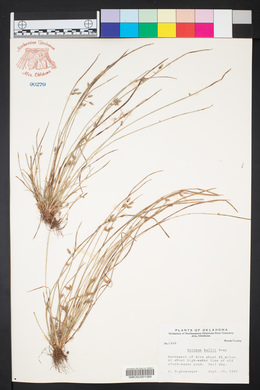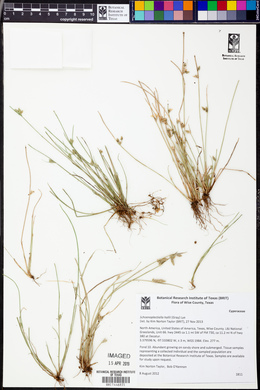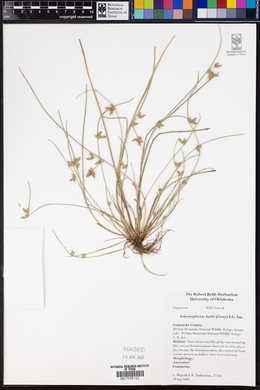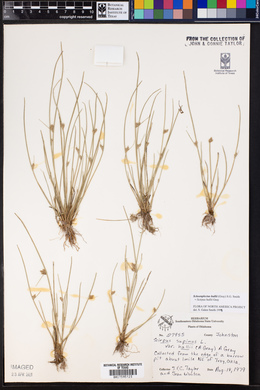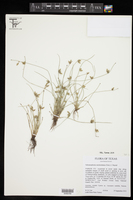Schoenoplectiella hallii
|
|
|
|
Family: Cyperaceae
Hall’s Bulrush, more...Hall's bulrush
[Schoenoplectus hallii (A. Gray) S.G. Sm., moreScirpus hallii A. Gray] |
Plants annual; rhizomes 1 mm diam. Culms often arching to decumbent, cylindric, ridged when dry, 0.05-0.8 m × 0.5-1 mm. Leaves 3-4, 1 cauline; sheaths straw-colored to brown and disintegrating to fibers, front translucent and splitting; blades 1-2, proximally thickly C-shaped in cross section, distally flat, from much shorter to longer than sheath, 1-200+ × 0.2-1 mm, smooth or margins distally spinulose. Inflorescences capitate or 1 spikelet or rarely with 1 or 2 branches to 12 mm; proximal bract erect, resembling leaf blades, 5-150 mm. Spikelets 1-5, 5-20 × 2-3 mm; scales straw-colored to pale orange-brown to nearly colorless, midrib region usually greenish or pale, ovate, 2.5-3(-5) × 1.5 mm, smooth or awn sparsely spinulose, margins ciliolate, midrib keeled distally, apex entire, rounded, awn 0.2-0.3 mm or to 3 mm on proximal scale. Flowers: perianth absent; anthers 0.4 mm; styles 2-fid. Spikelet achenes blackish brown, plano-convex or usually the adaxial surface longitudinally concave, ovoid to obovoid, 1.3-1.7 × 1.2-1.3 mm, with 15-18 mostly sharp ridges; beak 0.1 mm. Amphicarpic achenes thickly trigonous with convex abaxial face, 1.7-2.5 × 1.1-1.6 mm, rugose with rounded ridges; beak 0.3 mm. 2n = 22. Fruiting summer-fall. Terrestrial to emergent, freshwater shores, temporary ponds, wet places in cultivated fields, pastures, ditches, sinkholes, prairie; 70-700 m; Ga., Ill., Ind., Kans., Ky., Mass., Mich., Mo., Nebr., Okla., Wis. Many reports of Schoenoplectus hallii are based on misidentified specimens of S. saximontanus or S. erectus. The Iowa specimen was probably collected in 1890. The species is probably extirpated from Massachusetts. I have identified a specimen from the Georgia coastal plain, where S. hallii and S. erectus are sympatric, as intermediate between the two.
Annual herb with thin rhizomes, tufted 5 cm - 0.8 m tall Leaves: three to four, basal, one growing on the culm. Sheaths straw-colored to brown, becoming fibrous, the fronts translucent and splitting. Ligules membranous. Blades one to two, 1 mm - 20 cm long (or longer), to 1 mm wide, shorter or longer than sheath, basally thickly C-shaped in cross-section, becoming flat towards the tip, sometimes bearing small marginal spines near the apex. Inflorescence: composed of one to five spikelets, terminal, subtended by bracts. Lowest bract leaf-like, often upright, 0.5 - 15 cm long. Flowers: minute, subtended by a floral scale, lacking sepals and petals. Stamens three, exserted. Anthers under 0.5 mm long. Pistil one. Style linear, two-cleft. Fruit: a one-seeded achene of two types. One type dark brown, about 1.5 mm long (including beak), under 1.5 mm wide, egg-shaped to reverse egg-shaped, beaked, flat on one side and convex on the other or upper surface longitudinally concave, bearing fifteen to eighteen sharp ridges. Other type 1.5 - 2.5 mm long (including beak), 1 - 1.5 mm wide, beaked, three-sided with a convex upper face, wrinkled with rounded ridges. Culm: decumbent to arching, 5 cm - 0.8 m long, 0.5 - 1 mm wide, circular in cross-section, solid, internally spongy with air cavities. Spikelets: solitary or in clusters, 0.5 - 2 cm long, 2 - 3 mm wide, circular in cross-section, with eight or more floral scales. Floral scales spirally arranged, orangish brown to straw-colored or almost colorless with a green or pale midrib, 2.5 - 3 mm long, to 1.5 mm wide, egg-shaped with a rounded apex, awned, minutely hairy-fringed. Similar species: No information at this time. Flowering: late June to late August Habitat and ecology: Along shores, ditches, and in sand excavations. Also found in sandy meadows and in the flooded areas of cultivated fields. Occurence in the Chicago region: native Etymology: Schoenoplectus comes from the Greek words schoinos, meaning rush or reed, and plectos, meaning twisted, plaited, or woven, referring to the use of the culms for making useful objects. Hallii is named after Harvey Monroe Hall (1874-1932), a professor of botany and a pioneer in experimental taxonomy. Author: The Morton Arboretum From Flora of Indiana (1940) by Charles C. Deam Indiana Coefficient of Conservatism: C = 7 Wetland Indicator Status: OBL |
























